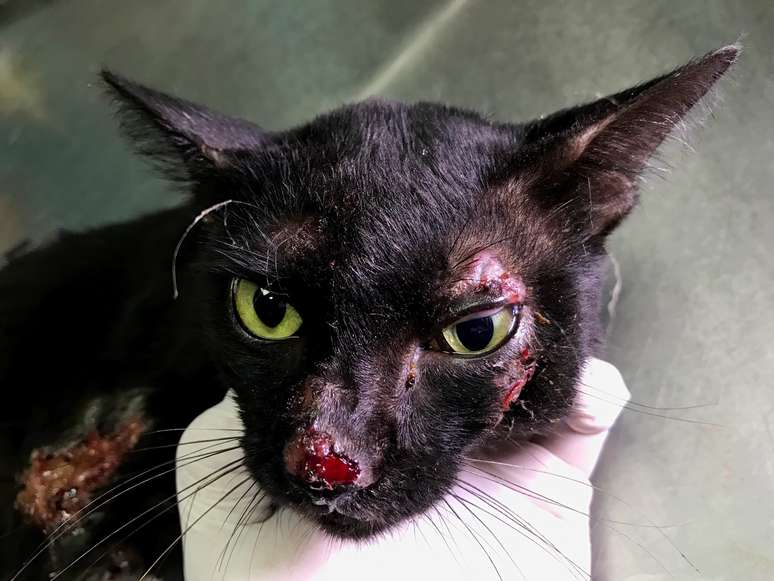The cat-borne disease is on the rise in Brazil and can also affect humans. Sporotrichosis is a disease caused by the fungus Sporothrix spp, present in soil, straw, vegetables and wood. The disease affects the skin of dogs and cats and is a zoonosis, that is, a disease that can be transmitted from animal to animal. […]
The cat-borne disease is on the rise in Brazil and can also affect humans
Sporotrichosis is a disease caused by the fungus Sporothrix spp, present in soil, straw, vegetables and wood. The disease affects the skin of dogs and cats and is a zoonosis, that is, a disease that can be transmitted between animals and humans, according to veterinarian Fernanda Binati.
The cats most affected by the disease, especially those that have access to the street and are not neutered. “Also, the dog does not shed a large amount of fungal spores in the lesions, which may not be the focus of the zoonosis,” he explains.
Transmission and symptoms
Infected cats transmit the disease through direct contact with wounds, scratches or bites. “The symptoms that indicate the problem are ulcerative lesions of the skin, with crusts and liquids, especially in areas such as the face, muzzle, nasal cavity and auricle. These lesions can also spread throughout the animal’s body. In case of disseminated lesions, clinical signs may include fever and apathy”, explains Fernanda.
Sporotrichosis has a cure!
Veterinarians diagnose sporotrichosis through microscopic evaluation of lesions, mycological examination, and, in some cases, histopathological examination. “Treatment of sporotrichosis involves the use of systemic and topical antifungals. After improvement of clinical signs, laboratory evaluations are recommended to complete treatment.”
Pay attention to prevention
According to the veterinarian, prevention involves the neutering of male felines with access to the street, “to avoid territorial fights. Furthermore, it is necessary to limit the access of this animal to the street, as well as to other cats and humans, until the end of the treatment .” To prevent people from becoming infected, Fernanda recommends not touching wounds, especially those of felines, without using gloves.
The contamination of man
The infectologist and coordinator of the Hospital Infection Control Service (SCIH) of the São Luiz Morumbi Hospital, Fernando de Oliveira, explains that humans can also be contaminated through contact with decaying vegetation, wood chips and bush thorns , and the disease is limited to the skin. “Generally, in the place where the fungus was inoculated, a papule (small solid lesion) or a pustule (vesicle with a dark liquid inside) usually appears.
It normally causes no other symptoms and usually increases in size within a few weeks, tending to form a lump. The lymphatic tissue may also be affected, forming a sort of path of nodules along the path of the first lesion, as if it were a rosary. The disease can also manifest itself on the mucous membranes and, in these cases, the eyes are the most affected”, explains the infectious disease specialist. In patients with lower immune defenses, due to other diseases, sporotrichosis can be more extensive.
How to identify the disease in people?
Veterinarians diagnose the disease by culturing the skin lesion or affected organ, identifying the fungus. It is essential to inform your doctor in case of contact with cats. “The disease is treatable and, in some cases, can even improve without treatment, although this is rare. Treatment lasts at least two months, with an average of 3-4 months,” Oliveira emphasizes.
Prevention
The infectious disease specialist recommends, in addition to what is recommended by the veterinarian Fernanda, that:
- The animal must be monitored by a veterinarian and must not be abandoned;
- The pet’s toys and objects must be cleaned frequently;
- If the diseased animal dies, to prevent the fungus from continuing in nature, seek means of cremation;
- When handling plants, cleaning the yard and carrying out rural work, it is also recommended to use appropriate gloves, clothing and footwear.
Attention!
The pet Never must be abandoned or sacrificed. Just like humans, there is a cure for them too.
Source: Terra
Rose James is a Gossipify movie and series reviewer known for her in-depth analysis and unique perspective on the latest releases. With a background in film studies, she provides engaging and informative reviews, and keeps readers up to date with industry trends and emerging talents.







